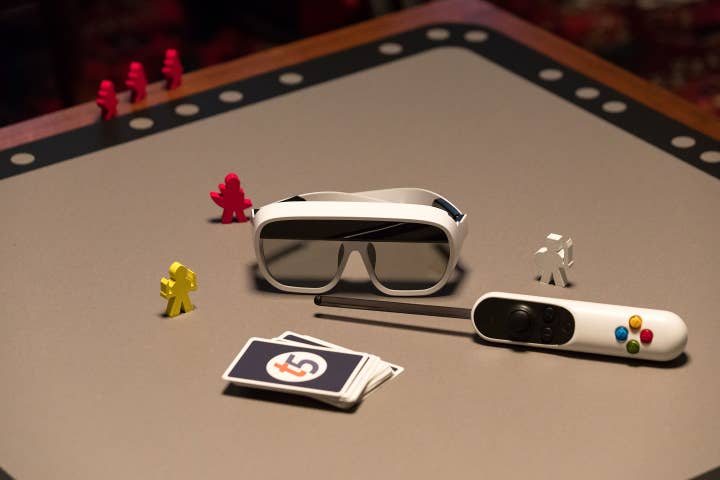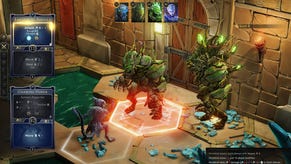What Tilt Five learned from the funding, focus stumbles of CastAR
Tilt Five CEO Jeri Ellsworth shares lessons on VC backing and strategic focus from AR tabletop outfit's VR/AR predecessor
Several years ago, CastAR seemed positioned to capitalize on booming interest in augmented reality and virtual reality. The VR/AR system was unveiled in 2013 as both of those spaces were heating up. A successful Kickstarter campaign proved out a certain amount of interest in the product, and that was followed by venture capitalists putting millions into the project and CastAR creating one new development studio from scratch and acquiring another.
Less than a year later, the company shut down. But the story of CastAR didn't quite end there. Some of the key developers on that project acquired the underlying technology and went back to work on the idea. The result is Tilt Five, an AR platform designed specifically around one of the original use cases in the CastAR pitch video: holographic tabletop gaming.
As of this writing, the Kickstarter campaign for Tilt Five is at about $1.4 million -- more than triple its original goal -- with 11 days to go. It's already significantly outstripped the Kickstarter campaign for CastAR, which attracted over $1 million in pledges on a goal of $400,000 back in 2013.
Jeri Ellsworth, former Valve hardware developer and co-founder of both CastAR creator Technical Illusions and Tilt Five explains how one led to the other, and what she learned along the way, in a conversation with GamesIndustry.biz. In our discussion, Ellsworth says the Kickstarter process in particular is "radically different" this time around.
"All of a sudden, the identity of the company was lost. We were chasing after everything from military simulations to dollhouses for 12-year-olds"
"First of all, the product is pretty much done, which is a huge benefit," she says. "Second, we know how to market now, so we're not as green and it was strategically planned out months in advance. In the CastAR days, we were new to it all, just flipped the switch on and that was it.
"We learned a lot about the industry as well, to identify the segment we were going to go after and to make sure we had all the features and content in place for that audience."
That was a key learning for Ellsworth from CastAR. Tilt Five is very specifically focused around incorporating gaming technology into traditional tabletop gaming. With CastAR, she says the team was more promoting technology for technology's sake.
"When we did CastAR, there was so much hype around VR, and AR was just starting to emerge, and I don't think many people in that AR space were really focusing on 'What segment are we going to go after?' or 'What's our audience?' So we were just throwing a piece of technology out there and saying it could do everything under the sun. A lot of AR and VR companies have struggled since because they don't have a clear vision of where they're going."
Another area where hindsight might help was the decision to find VC funding. Obviously, people who put $15 million into a project will want some say in how things go. Ellsworth says one of the first things they wanted to do was change the company's strategic road map to focus more on a closed platform strategy. CastAR complied, although Ellsworth says she's proud to have insisted on the company then refunding its Kickstarter backers for the changes to the original plan.
However, it wasn't necessarily the "closed platform" part of the strategy that had the biggest repercussions.
"They took us in all kinds of crazy directions," Ellsworth recalls. "All of a sudden, the identity of the company was lost. We were chasing after everything from military simulations to dollhouses for 12-year-olds."
The new management's aggressive growth strategy also shortened the runway the company had to hit any of those targets.
"I've learned what code words to look for when talking to VCs, and I've turned down quite a bit of money this year just because the red flags were going up"
"In Silicon Valley, there's a lot of interest in fluffing a company up and dumping it fast, so we fell into that trap of our investors trying to ride the hype of virtual reality," Ellsworth says, adding, "They took our company, which was about 20 people, and grew it like overnight to 90 people. They burned through all the cash and just cratered the thing into the ground. And that left the core team sitting there saying, 'Oh my god, what just happened to us?' That's where a group of us pooled our money and purchased the assets and said, 'We're never going to let that happen again.'"
While Tilt Five still went after (and landed) VC funding, Ellsworth says that as with so many parts of the business, she has pulled valuable lessons from the CastAR experience.
"We're a lot smarter about what money we take this time around," Ellsworth says. "I've learned what code words to look for when talking to VCs, and I've turned down quite a bit of money this year just because the red flags were going up."
One of those red flags is when would-be VC backers offer to invest money in a company so long as they're allowed to "bring in some adult supervision."
"I just want to say, 'Fuck you, I've run huge groups. I've shipped products that shipped in the tens of millions. I don't need 'adult supervision,'" Ellsworth says. "That's just code for they want to bring their buddies in.
"But that's how Silicon Valley works in a lot of ways. They really want to fuck you up and get a quick exit. So we've been taking money from other VCs that have more of a longer term focus on growing companies, because that's what's needed in this space. In 2013, when we took the money, everyone thought AR and VR was going to take off and be a thing in two or three years. Now we're smarter and we know it's going to be more of a ten to 15-year time horizon."

That's not the only thing Ellsworth is taking a different approach to this time around. As she alluded to above, Tilt Five is "hyper-focused on making sure we can nail one segment of the market and expand from there." That's actually been a painful focus for her to maintain at times, she says, particularly when contacted by developers in education or other fields where they believe the system would work well.
Tilt Five has also put an emphasis on making it easy for developers to work with the hardware. CastAR had essentially no tools to help developers incorporate the hardware into their designs, but Tilt Five is "drag-and-drop" for Unity and Unreal developers.
"The hardware business runs at a little bit different pace [than software]"
And despite that focus on dev tools to reduce friction, Tilt Five won't be using them to make content for the platform.
"That was a huge learning for us at CastAR," Ellsworth says. "When we got spread thin with trying to do first-party content plus the hardware plus the marketing, it was just way too much for a start-up."
To that end, Tilt Five has lined up a number of third-party partners to produce content for Tilt Five, including SmiteWorks and its virtual tabletop Fantasy Grounds, which in and of itself provides users with access to thousands of pen-and-paper RPG adventure packs for games like Dungeons & Dragons, Call of Cthulhu, Pathfinder, and more. Other partners include Monocle Society (maker of the storytelling game Weave), licensed virtual board game purveyor Tabletopia, more traditional video game developers like Niffler (Chuck's Challenge 3D) or Beatshapers (#killallzombies, StarDrone), and others.
One other big difference has been in the company's approach to communication and community building. At CastAR, Ellsworth said the team basically went radio silent on interested consumers once they had investors. With Tilt Five, the plan is to be open and constantly communicating, mirroring games-as-a-service development as much as possible.
So far the results have been mixed. Ellsworth said the Discord has seen a lot of interested people signing up, but suspects it's not quite as effective a tool for Tilt Five as it would be for indie developers simply because "the hardware business runs at a little bit different pace" than software. It can also be tricky communicating the precise challenges of hardware development to an audience accustomed to the response times of modern game development.
"It's been kind of fun communicating to them, 'No, we can't add a button to the joystick because we've already cut tools and tools take months to make, so this is kind of what you get. But we'll consider that for the next generation," Ellsworth says.
However, that's not to say the feedback isn't helpful. She notes that it was community feedback that prompted the team to add webcam compatibility to facilitate Twitch streaming, so that the audience could easily see the game table as well as the players as they would appear in-game to each other.
The first units of Tilt Five are expected to ship to backers in June. That batch is pre-sold out, and at the time of our discussion, Ellsworth said July's run was virtually pre-sold out as well.










